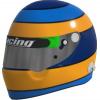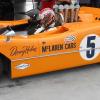
The inevitable wheel tethers thread
#1

Posted 19 July 2009 - 20:47
This F1 season, after the introduction of wheel tethers several years ago, there are still the odd wheel flying around after an incident.
And of course, today, a driver has been killed by one - the angle at which was impossible to protect from, and the run off area a moot point (he was inconscious after the impact, probably sat with a wide open throttle - although I do think a jerk measuring device and or accelerometer attached to a helmet in order to cut off the engine could be a good idea)
So here, things to discuss: Are wheel tethers good enough? What are the limiting factors on tether strength? Could they be improved by implementing multiple tethers?
Advertisement
#2

Posted 19 July 2009 - 21:04
#3

Posted 19 July 2009 - 21:08
#4

Posted 19 July 2009 - 21:10
#5

Posted 19 July 2009 - 21:11
That might hinder getting out.
It could be hinged with some way of locking it in place.
#6

Posted 19 July 2009 - 21:12
I had an idea - we have a roll hoop so that a helmet doesn't touch the ground in the event of going upside down. Could we not have a similar hoop built over the cockpit to take the load of anything that might be heading into the cockpit?
then you get into visibility issues and ingress/egress difficulties.
#7

Posted 19 July 2009 - 21:12
This was a freak accident.
We've not seen its like for nearly 30 years.
It is not necessary to radically change the nature of single seater racing cars.
#8

Posted 19 July 2009 - 21:13
#9

Posted 19 July 2009 - 21:14
then you get into visibility issues and ingress/egress difficulties.
If it goes above the helmet then you won't have any visibility issues. There could be a button inside the cockpit to release a locking bolt which then allows it to spring open on a hinge.
#10

Posted 19 July 2009 - 21:16
#11

Posted 19 July 2009 - 21:18
#12

Posted 19 July 2009 - 21:19
Agreed. Two cars had a pretty ordinary accident, and both cars lost a rear wheel. If they have tethers in those cars, then they're purely for show.To me, it didn't even look like the cars had tethers at all. Wheels flying everywhere. Those cars just disintegrated.
#13

Posted 19 July 2009 - 21:23
Yeah, that was my impression too.To me, it didn't even look like the cars had tethers at all. Wheels flying everywhere. Those cars just disintegrated.
#14

Posted 19 July 2009 - 21:24
Tethers can only be made so strong. If you make then unbreakable, all that energy of a flailing wheel will stay connected to the tub and just crack the tub in half. They are there to reduce the probability of a wheel coming lose, and they do a good job. The time may be coming where open cockpits need to go the route of F1 powerboats and have a canopy over top the driver.
you could do several things.
1. introduce shear/tension limited components at the wheel, so they break first, stop extra mass flying around.
2. introduce extra tethers - working in parallel means actual point stresses remain lower.
3. introduce the opposite of crumple zones - things that are desinged to break under tension to reduce the energy flying around in the wheels in the chassis
#15

Posted 19 July 2009 - 21:27
To me, it didn't even look like the cars had tethers at all. Wheels flying everywhere. Those cars just disintegrated.
In all fairness, you didn't think they wore HANS devices either and you were wrong about that too.
The real issue is Brands Hatch. Very high speed, very little run-off. Chances are, if you go off at Brands, you're going to be going into the tyre barrier at quite a lick and that's how tethered wheels come off.
It was a freak accident. Motor racing is a dangerous sport and today's tragedy is a reminder of that. Kneejerk safety measures and blame culture are not the correct way to respond to Henry's death.
#16

Posted 19 July 2009 - 21:28
I had an idea - we have a roll hoop so that a helmet doesn't touch the ground in the event of going upside down. Could we not have a similar hoop built over the cockpit to take the load of anything that might be heading into the cockpit?
Hmm, isn't it called closed cockpit?
#17

Posted 19 July 2009 - 21:29
To me, it didn't even look like the cars had tethers at all. Wheels flying everywhere. Those cars just disintegrated.
What did you expect from low budget crap wagon?
#18

Posted 19 July 2009 - 21:30
Hmm, isn't it called closed cockpit?
Not if you have just a hoop rather than enclosing the whole thing.
#19

Posted 19 July 2009 - 21:31
Just want to say one thing: some people are already saying that F2's low budget was the reason for the accident, while wheels getting loose happen in every open wheels series, F1 included, just watch Vettel and Kubica incident from Melbourne. So let's not jump to conclusions too soon.
My point is that F2 has Formula Palmer Audi budgets with GP2 speeds. Something has to give. F1 has not had a fatality for 15 years. Low cost F2 has a fatality after four races.
It was pointed out in another thread that "what could crash tests do", but they could determine how strong the wheel tethers are, and ensure that the height of the cockpit is such that wheels don't kill drivers. Remember, the height of the back of the cockpit was raised after DC nearly ran over Wurz's head. This was to stop wheels hitting the driver, whether connected to a car or not.
So, my question is, are the crash tests and safety requirements the same for F2 as F1. If not, why? The only concievable reason could be cost. In which case, F2 should increase it's budget requirements to encompass safety.
I have a 7 year old that I would like to get into karting and beyond. I wouldn't enter him into anything that is cheap but has a high likelyhood of death. (At the moment, competing in F2 carries a 25% chance of death).
Nobody in the business that I know could understand how F2 could opperate under the budget constraints. Now after 4 races, we have a fatality. Coincidence?
Advertisement
#20

Posted 19 July 2009 - 21:31
It was a freak accident.
nope, like I said at the top of the thread, 2 marshalls died earlier in the decade, and there's still wheels flying around. It's something that needs to be discussed. Spectators and marshalls as well as drivers are at risk.
#21

Posted 19 July 2009 - 21:36
(At the moment, competing in F2 carries a 25% chance of death).
Nobody in the business that I know could understand how F2 could opperate under the budget constraints. Now after 4 races, we have a fatality. Coincidence?
It does not carry a 25% chance of death and it is ridiculous to say so.
And yes, it is entirely coincidence.
This accident could have happened in F1, Indycar, GP2, F3, A1GP or any open cockpit series.
#22

Posted 19 July 2009 - 21:37
I don't think there is anything you could have done to prevent this accident bar forcing them to racing with roofs on. It's just a terrible tradegy.
With the cost issues, well if you add on all safety devices F1 cars use, I think you will find F2, GP2, F3, Forumla Renault ect.... becomes to expensive for teams to race in. Motorsport is dangerous but the safety factor is currently evolving and will continue to do so. I'm sure there are lessons are learnt of all accidents.
#23

Posted 19 July 2009 - 21:38
(At the moment, competing in F2 carries a 25% chance of death).
#24

Posted 19 July 2009 - 21:40
It does not carry a 25% chance of death and it is ridiculous to say so.
And yes, it is entirely coincidence.
This accident could have happened in F1, Indycar, GP2, F3, A1GP or any open cockpit series.
4 races, 1 death = 25%.
Could have, but didn't. Like I said, when DC nearly ran over Wurz's head, they raised the height of the back of the cockpit. Is this the case for F2?
#25

Posted 19 July 2009 - 21:42
4 races, 1 death = 25%.
Could have, but didn't. Like I said, when DC nearly ran over Wurz's head, they raised the height of the back of the cockpit. Is this the case for F2?
try 8 races * 26 drivers = 208 driver races. thats less than half of 1 % if you're gonna play bullshit statistics.
#26

Posted 19 July 2009 - 21:44
4 races, 1 death = 25%.
Could have, but didn't. Like I said, when DC nearly ran over Wurz's head, they raised the height of the back of the cockpit. Is this the case for F2?
You could claim that if you were the only driver taking part, but even then it'd be a nonsense argument.
#27

Posted 19 July 2009 - 21:52
My point is that F2 has Formula Palmer Audi budgets with GP2 speeds. Something has to give. F1 has not had a fatality for 15 years. Low cost F2 has a fatality after four races.
It was pointed out in another thread that "what could crash tests do", but they could determine how strong the wheel tethers are, and ensure that the height of the cockpit is such that wheels don't kill drivers. Remember, the height of the back of the cockpit was raised after DC nearly ran over Wurz's head. This was to stop wheels hitting the driver, whether connected to a car or not.
So, my question is, are the crash tests and safety requirements the same for F2 as F1. If not, why? The only concievable reason could be cost. In which case, F2 should increase it's budget requirements to encompass safety.
I have a 7 year old that I would like to get into karting and beyond. I wouldn't enter him into anything that is cheap but has a high likelyhood of death. (At the moment, competing in F2 carries a 25% chance of death).
Nobody in the business that I know could understand how F2 could opperate under the budget constraints. Now after 4 races, we have a fatality. Coincidence?
I do not think the cost of the series to enter has anything to do with this. It is a tragic accident and could have happened in any series. You math is so far beyond belief I am almost offended by it. I am convinced what we saw today was a tragic tragic accident.
#28

Posted 19 July 2009 - 21:54
I do not think the cost of the series to enter has anything to do with this. It is a tragic accident and could have happened in any series. You math is so far beyond belief I am almost offended by it. I am convinced what we saw today was a tragic tragic accident.
So why did F1 increase the rear cockpit height to stop wheels from hitting heads after the DC/Wurz incident?
#29

Posted 19 July 2009 - 21:54
nope, like I said at the top of the thread, 2 marshalls died earlier in the decade, and there's still wheels flying around. It's something that needs to be discussed. Spectators and marshalls as well as drivers are at risk.
You really don't understand this whole "Motor Sport Is Dangerous" concept do you?
If you want to 100% remove the possibility of someone getting killed in motor racing, you don't motor race at all. That's the only "solution".
#30

Posted 19 July 2009 - 21:57
It's got nothing to do with Brands.In all fairness, you didn't think they wore HANS devices either and you were wrong about that too.
The real issue is Brands Hatch. Very high speed, very little run-off. Chances are, if you go off at Brands, you're going to be going into the tyre barrier at quite a lick and that's how tethered wheels come off.
It was a freak accident. Motor racing is a dangerous sport and today's tragedy is a reminder of that. Kneejerk safety measures and blame culture are not the correct way to respond to Henry's death.
I only watched my first F2 race today, due to it being unheard of in the States, and I didn't see they were wearing HANS, and I had read somewhere else that they didn't.
HANS or no HANS, nothing would have saved Henry today except for a decent wheel tether. I've watched the video and at no point do you see a sign of one. Not even trailing from the chassis.
#31

Posted 19 July 2009 - 21:59
Edited by MonkeyBoy, 19 July 2009 - 22:02.
#32

Posted 19 July 2009 - 22:00
You really don't understand this whole "Motor Sport Is Dangerous" concept do you?
If you want to 100% remove the possibility of someone getting killed in motor racing, you don't motor race at all. That's the only "solution".
yes, motorsport is dangerous. However, unecessary risk is supposed to be removed. It's an unecessary risk to have wheels flying around, there could have been two drivers killed by that wheel today. Possibly a spectator or a marshall as well.
Every single racing driver is concious of his own safety and will be unhappy about an unecessary risk. Heard of the GPDA? They're always pushing for safety standards to be improved - that's why they exist.
You can't let someone die from an accident caused by something that should have been rectified after the marshalls in melbourne and monza died without changing anything.
#33

Posted 19 July 2009 - 22:01
My point is that F2 has Formula Palmer Audi budgets with GP2 speeds. Something has to give. F1 has not had a fatality for 15 years. Low cost F2 has a fatality after four races.
Yet, F2 meets F1 2005's safety regs, even thought it runs at lower speeds. Just browse through F1 incidents in the last few years on youtube and count how many wheels were flying off. It's not a rare occurrence, this is what happens during high speed crashes. It surely needs to be looked into as cars are never safe enough but to claim that Surtees died because of budget safety standards is ridiculous.
edit: BTW: Hans are mandatory in F2.
Edited by wingwalker, 19 July 2009 - 22:03.
#34

Posted 19 July 2009 - 22:03
So why did F1 increase the rear cockpit height to stop wheels from hitting heads after the DC/Wurz incident?
F2 cars have the same spec cockpit protection as F1 cars as you can see here:
http://www.autosport....php/id/1311921
#35

Posted 19 July 2009 - 22:04
#36

Posted 19 July 2009 - 22:07
Yet, F2 meets F1 2005's safety regs, even thought it runs at lower speeds. Just browse through F1 incidents in the last few years on youtube and count how many wheels were flying off. It's not a rare occurrence, this is what happens during high speed crashes. It surely needs to be looked into as cars are never safe enough but to claim that Surtees died because of budget safety standards is ridiculous.
edit: BTW: Hans are mandatory in F2.
Some sense at last
#37

Posted 19 July 2009 - 22:07
The real issue is Brands Hatch. Very high speed, very little run-off. Chances are, if you go off at Brands, you're going to be going into the tyre barrier at quite a lick and that's how tethered wheels come off.
Tis sad but true about the back section of the GP track. The chances of this kind of accident are extremely high round there unfortunately.
We shouldnt turn a blind eye to this problem. If something can be addressed it should. Hopefully there'll be a proper investigation into the strength of the wheel tethers in F2 at the very least.
Edit: having seen the accident again the first crash looked hard enough to overcome a strong wheel tether. After Henry had been struck and went off himself, I would have expected his rear wheel to stay on but it too flew off and back into the road.
Edited by Tenmantaylor, 19 July 2009 - 22:10.
#38

Posted 19 July 2009 - 22:07
So why did F1 increase the rear cockpit height to stop wheels from hitting heads after the DC/Wurz incident?
Then is it unsafe for people to race their historic formula (1 or otherwise) cars from the 90s, 80s and 70s?
Not only do they have poor protection, the early models have weak tube frames...
2006 F1 safety standards for the F2 car, is still quite recent and more than reasonable in principle.
#39

Posted 19 July 2009 - 22:08
If they can engineer it so the tyres can't leave the cars, then that would be an improvement, but accidents will always happen, motor racing will always be dangerous.
Edited by pRy, 19 July 2009 - 22:09.
Advertisement
#40

Posted 19 July 2009 - 22:10
Clearly today was a freak accident. However I did mention on another forum back in April that the tethers were worryingly weak in Kubica's Melbourne accident but more specifically in Sutil's crash in China were the wheel was easily ripped from the chassis and thrown towards the cars on track. We could have had a similar incident to today's. Without doubt the FIA have to look at strengthening them.
The FIA could supply a sufficient gauge cable, and supply some heavy brackets so teams can solidly attach it to the wheel and to the car?
#41

Posted 19 July 2009 - 22:14
#42

Posted 19 July 2009 - 22:14
You really don't understand this whole "Motor Sport Is Dangerous" concept do you?
If you want to 100% remove the possibility of someone getting killed in motor racing, you don't motor race at all. That's the only "solution".
I feel for John and his family at this time and I'm sure he will have not the slightest sense of blaming safety standards. He raced bikes at the Isle of Mann, F1 cars through the most dangerous decade, and continues to go out on the track in/on old cars and bikes. We do it in spite of the risks involved, not because of them. Joe Public probably thinks other wise and you will never change the perception of those who come from a stance of total ignorance. Motor sport has an element of risk but to call it dangerous....???
There is a tendency in life today to try to ban anything which claims lives. What happened to Henry was terribly unfortunate and terribly unlucky. It was a freak accident but one which will in all probability be repeated at some time. Stopping a high energy spinning wheel in an impact is very difficult - wheel tethers are a good idea but hard to perfect. The safety people will continue to work to improve safety but the big gains have been made. Incremental improvements only are still available and predicting the trajectory of a bouncing wheel is impossible.
Prayers go out to the Surtees family for their tragic loss.
#43

Posted 19 July 2009 - 22:17
Its been said before that the strength of the tethers isnt necessarily the problem as the anchor point often rips a whole in the tub. How about a tether that runs through to the other wheel? The chances of a flailing wheel having enough force to rip the other wheel off are very slim and if it did I doubt it could travel as far as easily.
true, although the front wheels are a different matter, as in the car the wheel is attached to, the wheel could arc towards the driver.
#44

Posted 19 July 2009 - 22:20
My point is that F2 has Formula Palmer Audi budgets with GP2 speeds. Something has to give. F1 has not had a fatality for 15 years. Low cost F2 has a fatality after four races.
I have a 7 year old that I would like to get into karting and beyond. I wouldn't enter him into anything that is cheap but has a high likelyhood of death. (At the moment, competing in F2 carries a 25% chance of death).
F2 don't have GP2 speed. Safety, given that they use the same standard as F1, should be better than for F1. Also, you need a course in statistics... There's not enough material to arrive at your conclusion.
#45

Posted 19 July 2009 - 22:57
The wheel swept diagonally over the car nose speed of impact being almost the sum of that of the car and the wheel. A matter of hundreds of a second and no luck.
I think the hit by the wheel was the death cause, not the crash into the barrier.
Edited by Dragonfly, 19 July 2009 - 22:58.
#46

Posted 19 July 2009 - 23:06
#47

Posted 19 July 2009 - 23:07
Replayed the incident many times. It's an absolutely freak and tragic at the same time coincidence.
The wheel swept diagonally over the car nose speed of impact being almost the sum of that of the car and the wheel. A matter of hundreds of a second and no luck.
I think the hit by the wheel was the death cause, not the crash into the barrier.
IMO he received fatal injuries before he hit the barrier. That wheel has what? 15 kilos? Surtees was travelling 200 km/h, roughly it is the impact of 900 newtons and thats equivalent to free fall of a 90 kg object.
Edited by brabhamBT19, 19 July 2009 - 23:08.
#49

Posted 19 July 2009 - 23:14
Tethers can only be made so strong. If you make then unbreakable, all that energy of a flailing wheel will stay connected to the tub and just crack the tub in half. They are there to reduce the probability of a wheel coming lose, and they do a good job. The time may be coming where open cockpits need to go the route of F1 powerboats and have a canopy over top the driver.
I've always said that there's no such thing as "safety first" when you have open cockpits. Canopies FTW.
#50

Posted 19 July 2009 - 23:14


























